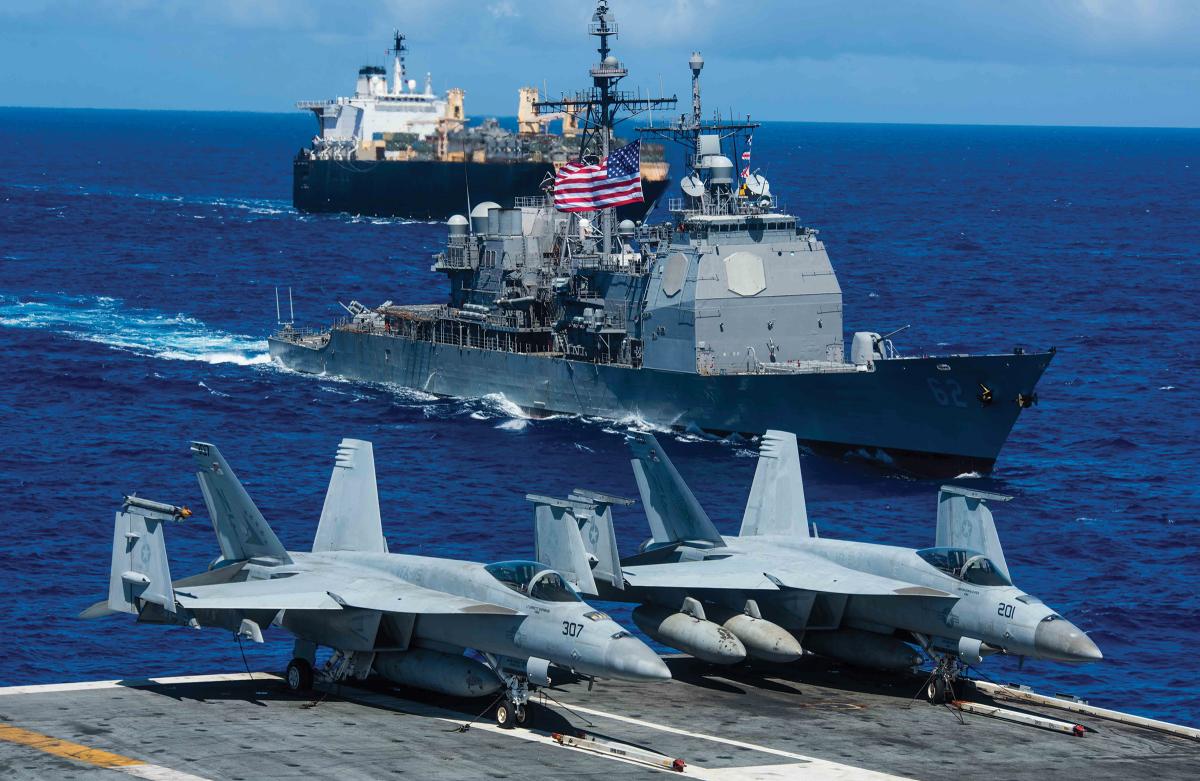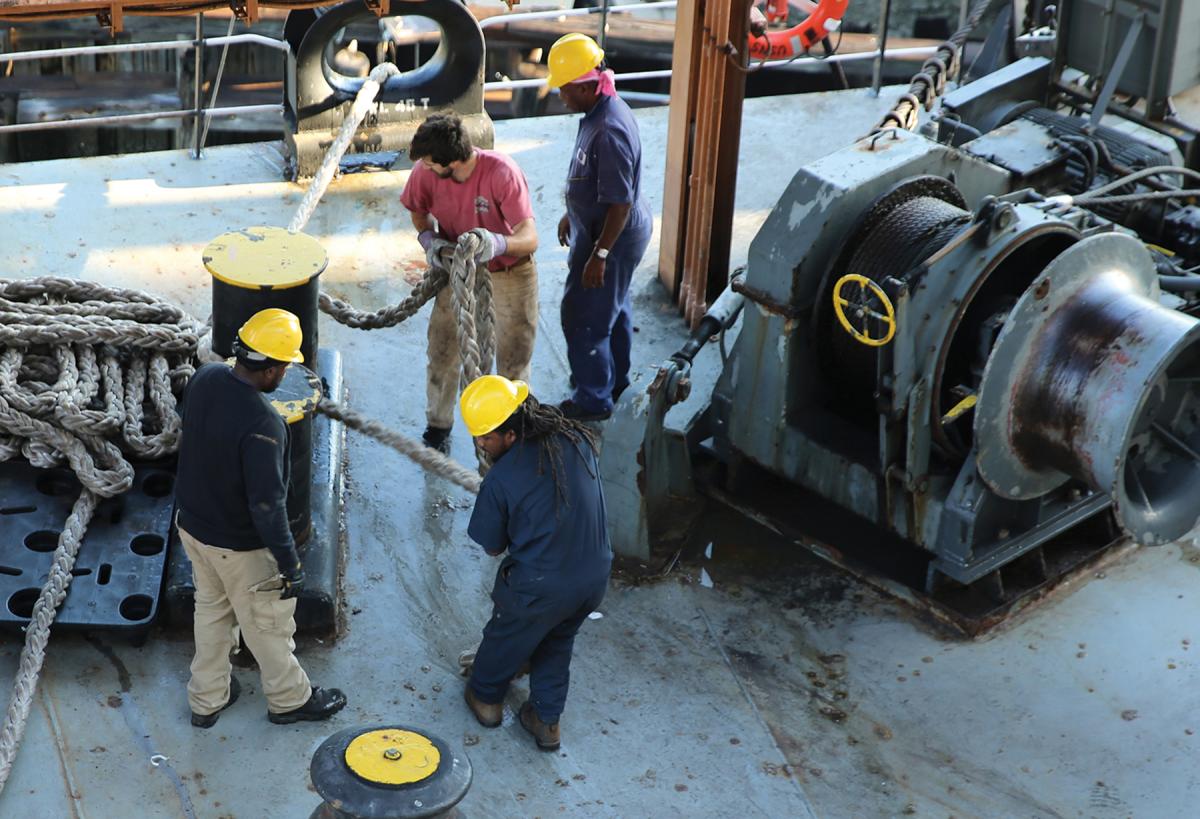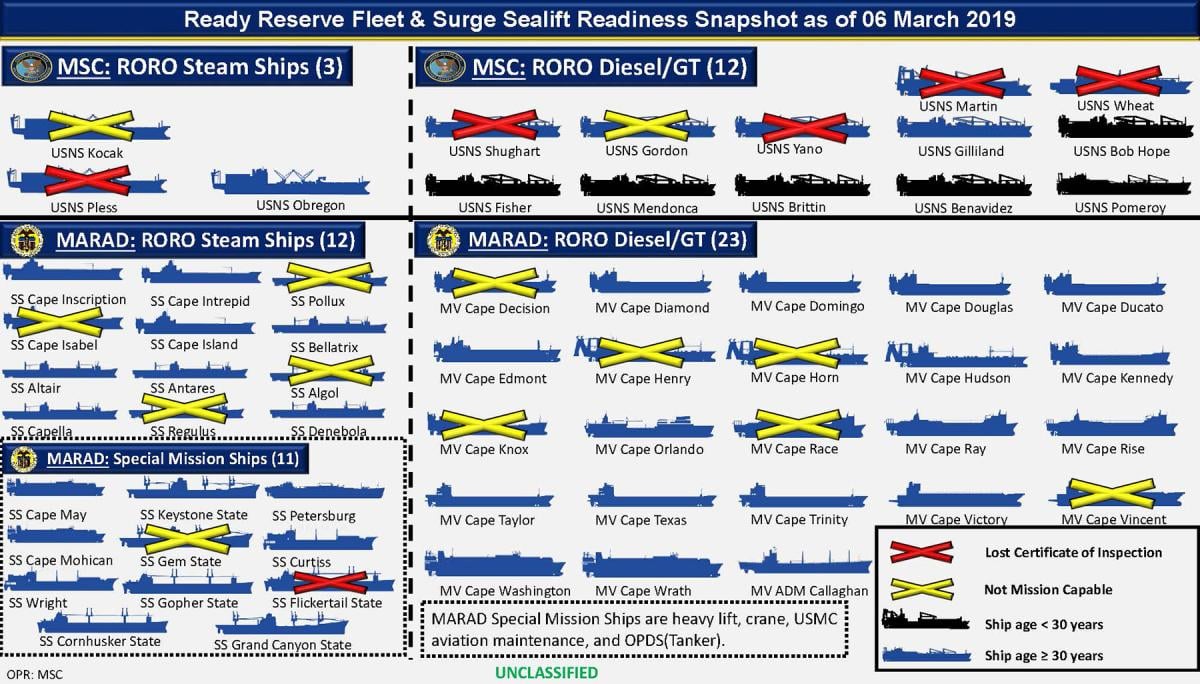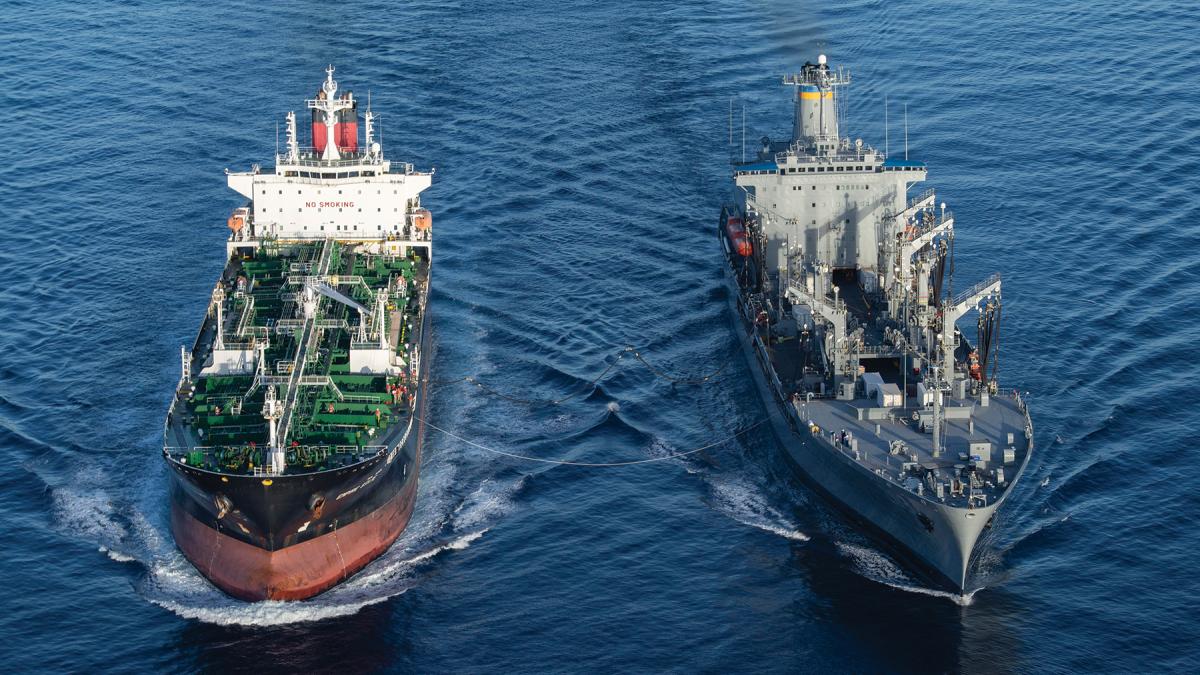In July 2002, the USNS Watson (T-AKR-310) departed her anchorage in Chagos Archipelago for the Port of Ash Shuaybah in Kuwait. Once pierside, she discharged 999 pieces of rolling stock and 437 containers from her 950-foot hull under the auspices of Exercise Vigilant Hammer. The Watson was the lead ship of an eight-ship class of new large medium-speed roll-on/roll-off (LMSR) vessels built after the 1991 Gulf War. Late in January 2003, the USNS Yano (T-AKR-297), one of five ships converted into LMSRs, arrived at the same Kuwaiti seaport and discharged more than 8,000 tons of equipment after sailing from Charleston, South Carolina, via the Strait of Gibraltar and the Suez Canal. Also from Charleston, the MV Maersk Missouri loaded containers for an Army field hospital. Using Maersk’s network, the cargo was shifted to the MV Maersk Antwerp for delivery to Ash Shuaybah.
These ships marked the beginning of a fleet that, from 2002 to 2011, delivered nearly 52 million tons of cargo for Operations Enduring Freedom and Iraqi Freedom. Government-owned, civilian-crewed ships such as the Watson and Yano were responsible for nearly half the cargo delivered. The rest traveled on commercial merchant vessels, such as the Maersk Missouri and Maersk Antwerp.1 As it has in every conflict in U.S. history, the merchant marine sailed and manned the ships loaded with the beans, bombs, and black oil needed for the fight. But what if the United States had a war and the merchant marine did not come?
Behind Every Great Leader . . .
The U.S. merchant marine has supported numerous wars and conflicts. In the 1898 war against Spain, 11 of the most modern mail steamers were taken into the U.S. Navy as auxiliary cruisers. From the East Coast, 43 merchantmen from the protected coastal trade—known today as the Jones Act fleet—were chartered to transport the V Corps; while on the West Coast, 17 larger international steamers hauled the VIII Corps to the Philippines.
In the early years of World War I, dependence on foreign shipping for most of its trade had left the United States without the necessary ships and mariners to get the American Expeditionary Force to the fight, and only 45 percent traveled by domestic shipping. A building program instituted by the Shipping Act of 1916 and the Merchant Marine Act of 1920 secured a larger merchant marine, protected in the domestic trade and operating on key overseas routes.2 In World War II, the Merchant Marine Act of 1936 ensured the nation possessed a large enough merchant fleet and sufficient mariners to support United Nations’ forces and transport the Arsenal of Democracy overseas.
In the Cold War era, during conflicts in Korea, Vietnam, and Kuwait, the United States was able to call on the commercial merchant fleet to support military operations. In all three conflicts, the nation chartered U.S.-flagged vessels to transport cargo to the areas of conflict. When the market could not provide, the nucleus fleet of merchant ships operated by the Military Sea Transportation Service (now MSC, the Military Sealift Command) and the reserve fleet, operated by the Maritime Administration (MarAd), were accessed, supplemented by foreign ships as needed.
As the years progressed, the age of the war-built fleet rose while its numbers dwindled. The introduction of new flags of registry, with ships cheaper to build, operate, and document; the advent of the interstate highway and pipeline systems; the end of differential payments in the late 1980s; and the shift in domestic shipyards to naval vice commercial construction drove a decline in the U.S. merchant marine. From a peak of 1,288 ships in 1951, today only 180 ships of more than 1,000 gross tons remain active in the U.S. merchant marine.3
Between Order & Disorder Is Logistics
The United States’ maritime transportation strategy today rests on the sealift trident:
- Rapid response by government-owned and commercially chartered ships of the afloat prepositioning force
- A surge force of U.S.-flag merchant ships and those drawn from the reserve sealift fleets of Mar-Ad and MSC deploying from the continental United States
- Sustainment by the U.S. merchant marine, through its commercial fleet and corporate networks, to provide the supplies to maintain U.S. forces in the field
Prepositioning
In 1979, MSC stood up the Near-Term Prepositioning Force, seven chartered ships with equipment for a light Marine brigade. The ships sailed to Diego Garcia in the Indian Ocean and awaited a call to action. In the mid-1980s, they were replaced by 13 maritime prepositioning ships stationed in three squadrons around the world. In 2012, the European squadron was eliminated. Today, Maritime Prepositioning Ship Squadron (MPSRon) 2 of seven ships is based at Diego Garcia and MPSRon 3 of seven ships is in the western Pacific. An Army squadron of seven vessels and two ammunition-laden containerships for the Air Force are spread among the two sites.4
If there were a conflict in the Far East, Middle East, or Eastern Europe, how would they respond?
First, not all the ships would be available due to routine maintenance.5 While MPSRon 2 and 3 could sortie rapidly, their transits could be difficult. The ships—a mix of government-owned and chartered vessels—are crewed by merchant mariners, with only a few naval personnel embarked on designated flagships for planning and communication. In addition, the ships lack self-defense measures, meaning they will require escorts. But according to Maritime Administrator Rear Admiral Mark Buzby, the Navy has said it “will probably not have enough ships to escort us. It’s: ‘You’re on your own; go fast, stay quiet.’”6
Whether the MPS squadrons sail toward China, Iran, or Russia, they will have to traverse several key choke points. In the east, it is the South China Sea and the Malacca Strait. Any potential confrontation would require an MPSRon to sail by Chinese artificial bases, within surface-to-surface or air-to-surface missile range. Without escorts, the ships would be easy targets, especially in a large formation. The alternative would be for the ships to disperse and hide among the hundreds of other ships that sail daily through that area. The Marine Corps–loaded ships are all painted in commercial colors, but those supporting the Army are haze gray and would not blend in well. If the ships avoid the Malacca and East China Sea choke points, they would have to sail thousands of extra miles. China currently is extending its reach throughout the Pacific, in places such as Papua New Guinea and the Solomon Islands, threatening those choke points.
A transit though the Strait of Hormuz into the Persian Gulf would expose the ships to similar dangers, as demonstrated by the May 2019 attacks on four vessels off Fujairah and the two tankers struck the following month in the Gulf of Oman. U.S. merchant ships were exposed to such threats during the 1980s’ tanker war. The MV Bridgeton, a reflagged Kuwaiti tanker participating in the first escorted convoy, struck an Iranian-laid mine. The naval escorts lacked minesweeping equipment, so they continued the transit, following in the wake of the damaged Bridgeton as she negotiated the perilous waters.7
It would be even more difficult if both squadrons sailed to Europe. The ships would have to traverse the Bab el-Mandeb—site of numerous attacks on shipping from ashore in Yemen, such as the one on the former HSV Swift in October 2016—past numerous new Chinese bases, and then through the Suez Canal. The closing of or danger in either point would necessitate a voyage around Africa.8 In addition, passage to the Baltic states would necessitate passing near the Russian territory of Kaliningrad or to the Black Sea ports of Ukraine through the Turkish-controlled Bosporus and Dardanelles.
While the prepositioning ships are the first to respond when United States needs to land large-scale equipment in a trouble spot, they require a benign environment for transit and offloading, and it is not clear a potential adversary would allow this to happen.
Surge
The second prong of the sealift trident is surge shipping. In their March 2019 testimony, Admiral Buzby and U.S. Transportation Command head General Steve Lyons highlighted the dire state of the reserve fleet.9 The average age of the 61 ships that make up the combined MSC and MarAd sealift fleet is 44 years. More ominous, 13 of the vessels are “not mission capable”—a loss of more than 20 percent before hostilities even begin.
These ships are homeported along the U.S. East, Gulf, and West coasts and are maintained in reduced operating status with a cadre crew, with the goal to activate in five days. Ships along the West Coast would be the first to respond to a contingency in the Far East. According to Admiral Buzby and General Lyon, of the 19 ships in the Pacific, only 13 could respond. Of the 11 along the Gulf Coast and 31 on the East Coast, 7 would not be able to deploy, and 6 were awaiting required U.S. Coast Guard inspections.
Fortunately, the Panama Canal provides the nation the ability to swing assets from either coast, but its use is not guaranteed. A recent editorial, “While America Slept, China Gained a Stranglehold on the Panama Canal,” raises the specter that Chinese economic investment and commercial leverage could pressure the Panamanians into refusing the United States access.10 Nature and management of the canal may restrict ship drafts due to low water in the Gatun Locks and prohibit its use.11
In September 2019, U.S. Transportation Command initiated a turbo activation—so called because no notice is given prior to the event—of more than half the surge fleet to stress test the system and the vessels and test the operating companies’ ability to obtain the necessary mariners. Six ships from MSC and 27 from MarAd were activated. All but one were able to sail; the SS Regulus successfully activated but was unable to depart Beaumont due to reduced air draft under the Martin Luther King Bridge as a result of heavy rains. Some vessels sailed late and some issues were reported, but the ships tested appeared to perform well. However, the test lasted just ten days and nearly half the fleet was not tested.
Sustainment
The final element in the trident is sustainment shipping. For Operations Enduring Freedom and Iraqi Freedom, the U.S. merchant marine provided the majority of the sustainment effort. More than 31 million tons of the nearly 52 million tons of cargo went on commercial ships, the overwhelming majority on ships enrolled in the Maritime Security Program.
As of 15 September 2019, the U.S. commercial fleet consisted of 180 ships, 99 in the coastal Jones Act trade and the remainder in international commerce.12 For a conflict in Europe or the Middle East, the United States would have access to most of the MSP fleet, the U.S.-flagged containerships of Maersk Lines and Hapag-Lloyd; the RO/ROs of ARC Shipping, Seacor, and Liberty; and the heavy-lift freighters of US Ocean. A Pacific scenario would be more difficult, as only the nine containerships of APL currently serve the Far East. The military could charter and divert ships from the coastal trade, such as containerships operated by Matson and Pasha to Hawaii or by TOTE to Alaska.
Coastal tankers from Overseas Shipping Group and Crowley, along with the larger crude carriers of Alaska Transport Company and Polar Tankers, would be required to provide fuel for not only ground forces but also naval units, as only one tanker is in the surge sealift fleet.
It is a War of Logistics
Reports by the Government Accountability Office, Center for a New American Security, and RAND Corporation all highlight issues associated with the aging of the sealift fleet, the decreasing number of ships and mariners, and the potential impact on national security strategy. A recent CSBA report highlights the logistics shortfall the U.S. Navy can expect in the future, but it does not fully develop that issue with regard to the U.S. merchant marine.13 Current plans to replace the prepositioning ships and surge sealift are only a partial fix to the larger systemic issue that is the declining number of ships and mariners, the threat of peer-to-peer conflict, and our own neglect of the logistic pipeline. Two exercises later this year, Defender 2020 in Europe and the Pacific, will test the ability to deploy division-size forces overseas in a way not done since the Reforger and Team Spirit exercises. Yet, even this will involve only a portion of the sealift forces needed for a potential larger confrontation.
The decline of the merchant marine has been long in coming, but as in many disasters, people refuse to see the issue until it is upon them. Should another call go out for the merchant marine, it may not be—to paraphrase gCaptain CEO John Konrad—“Admiral, we are not ready for war.”14 Instead, it might be, “Admiral, we are unable to go to war.” Shortages in ships, shipbuilding and repair infrastructure, and mariners could play greater havoc with U.S. logistics than any outside threat.
It is time to put maritime logistics front and center. The merchant marine should be included in any new joint strategies. The military should ensure the Jones Act is maintained, that cargo preference is increased, and that Maritime Security Program funds and numbers are augmented to meet the needs of the U.S. military and commercial interests. Otherwise, the nation may find itself with military forces deployed overseas with no means to feed, arm, or sustain them.
1. See A. J. Herberger, Kenneth C. Gaulden, and Rolf Marshall, Global Reach: Revolutionizing the Use of Commercial Vessels and Intermodal Systems for Military Sealift, 1990–2012 (Annapolis: Naval Institute Press, 2015).
2. See Salvatore R. Mercogliano, “The Shipping Act of 1916 and Emergency Fleet Corporation: America Builds, Requisitions, and Seizes a Merchant Fleet Second to None,” Northern Mariner 26, no. 4 (October 2016): 407–24.
3. Tim Colton, “The Decline of U.S. Shipping,” 12 January 2016, www.shipbuildinghistory.com/statistics/decline.htm.
4. Military Sealift Command, 2018 in Review, www.msc.navy.mil/annualreport/2018/MSCAnnual18.pdf, and Salvatore R. Mercogliano, “Semper Sealift: The Partnership between the U.S. Marine Corps and Merchant Marine,” Naval History (April 2016).
5. In both Operation Desert Shield and Iraqi Freedom, two ships from MPSRon 2 were out of position and unable to immediately respond.
6. David B. Larter, “’You’re on Your Own’: US Sealift Can’t Count on Navy Escorts in the Next Big War,” Defense News, 10 October 2018.
7. Scott C. Truver, “Mine the Gap: Iranians and the Strait of Hormuz,” USNI News, 17 June 2012.
8. Sam LaGrone, “USS Mason Fired 3 Missiles to Defend from Yemen Cruise Missile Attack,” USNI News, 11 October 2016.
9. John Grady, “TRANSCOM, MARAD Want to Speed Up Purchase of Used Ships for Reserve Fleet,” USNI News, 7 March 2019. In their prepared testimony, General Lyons and Admiral Buzby presented a dismal snapshot of the Ready Reserve Fleet and surge sealift as of 6 March 2019, https://armedservices.house.gov/_cache/files/1/4/14380ece-153c-41a6-81bd-f4b91c1f8cc9/67423FBD2E9063DD27B4F3218C7E724D.rrf-surge-sealift-readiness-snapshot-unclas-v6mar18-n00-.pdf.
10. Editorial Board, “While America Slept, China Gained a Stranglehold on the Panama Canal,” St. Louis Post-Dispatch, 6 January 2019.
11. Henry Fountain, “What Panama’s Worst Drought Means for Its Canal’s Future,” New York Times, 17 May 2019.
12. Maritime Administration, “U.S. Flag Privately-Owned Fleet,” www.maritime.dot.gov/data-reports/data-statistics/overview.
13. Timothy A. Walton, Harrison Schramm, and Ryan Boone, Sustaining the Fight: Resilient Maritime Logistics for a New Era, Center for Strategic and Budgetary Assessments, 23 April 2019.
14. John Konrad, “Admiral, I am NOT Ready for War,” gCaptain.com, 8 May 2019.







